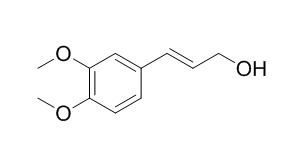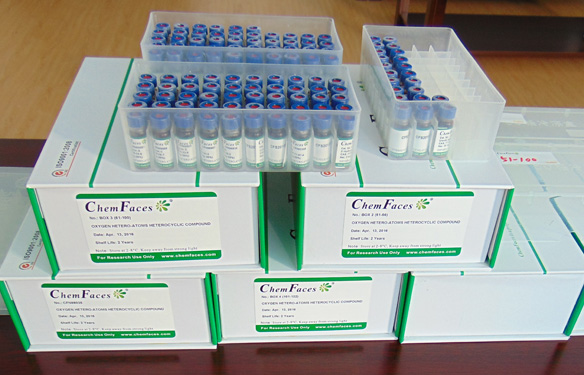3,4-Dimethoxycinnamyl alcohol
3,4-Dimethoxycinnamyl alcohol shows significant antimicrobial and cytotoxic activities.
Inquire / Order:
manager@chemfaces.com
Technical Inquiries:
service@chemfaces.com
Tel:
+86-27-84237783
Fax:
+86-27-84254680
Address:
1 Building, No. 83, CheCheng Rd., Wuhan Economic and Technological Development Zone, Wuhan, Hubei 430056, PRC
Providing storage is as stated on the product vial and the vial is kept tightly sealed, the product can be stored for up to
24 months(2-8C).
Wherever possible, you should prepare and use solutions on the same day. However, if you need to make up stock solutions in advance, we recommend that you store the solution as aliquots in tightly sealed vials at -20C. Generally, these will be useable for up to two weeks. Before use, and prior to opening the vial we recommend that you allow your product to equilibrate to room temperature for at least 1 hour.
Need more advice on solubility, usage and handling? Please email to: service@chemfaces.com
The packaging of the product may have turned upside down during transportation, resulting in the natural compounds adhering to the neck or cap of the vial. take the vial out of its packaging and gently shake to let the compounds fall to the bottom of the vial. for liquid products, centrifuge at 200-500 RPM to gather the liquid at the bottom of the vial. try to avoid loss or contamination during handling.
Phytomedicine.2018, 47:48-57
RSC Adv.2018, 32621-32636
Yakugaku Zasshi.2018, 138(4):571-579
Molecules.2021, 26(2):313.
Appl. Sci. 2021, 11(22), 10552
Hum Exp Toxicol.2022, 41:9603271221143713.
Molecular & Cellular Toxicology2017, 13(3):271-278
Antioxidants (Basel).2021, 10(10):1638.
Naunyn Schmiedebergs Arch Pharmacol.2021, 394(1):107-115.
PLoS One.2018, 13(11):e0208055
Related and Featured Products
Fitoterapia. 2003 Apr;74(3):308-11.
Antimicrobial and cytotoxic constituents of Loranthus globosus.[Pubmed:
12727502]
METHODS AND RESULTS:
(+)-Catechin, 3,4-Dimethoxycinnamyl alcohol and 3,4,5-trimethoxycinnamyl alcohol were isolated from the barks of Loranthus globosus.
CONCLUSIONS:
All compounds showed significant antimicrobial and cytotoxic activities.
Indian J Exp Biol. 2010 Mar;48(3):314-7.
Antileishmanial phenylpropanoids from Alpinia galanga (Linn.) Willd.[Pubmed:
21046987]
Hexane, chloroform and ethyl acetate extracts (100 microg/ml) of Alpinia galanga rhizomes exhibited significant activity in vitro against promastigotes of L. donovani.
METHODS AND RESULTS:
Twelve compounds namely, methyleugenol (1), p-coumaryl diacetate (2), 1'-acetoxychavicol acetate (3), 1'-acetoxyeugenol acetate (4), trans-p-acetoxycinnamyl alcohol (5), trans-3,4-Dimethoxycinnamyl alcohol (6), p-hydroxybenzaldehyde (7), p-hydroxycinnamaldehyde (8), trans-p-coumaryl alcohol (9), galangin (10), trans-p-coumaric acid (11) and galanganol B (12) were isolated from these extracts.
CONCLUSIONS:
Of these, compounds 2, 3, 4 and 5 were found most active in vitro against promastigotes of L. donovani with IC50 values of 39.3, 32.9, 18.9 and 79.9 microM respectively. This is the first report of antileishmanial activity of the extracts and isolated constituents of A. galanga.



